Abstract
Harnessing surplus wind and solar energy for water electrolysis boosts the efficiency of renewable energy utilization and supports the development of a low-carbon energy framework. However, the intermittent and unpredictable nature of wind and solar power generation poses significant challenges to the dynamic stability and hydrogen production efficiency of electrolyzers. This study introduces a multi-state rotational control strategy for a hybrid electrolyzer system designed to produce hydrogen. Through a detailed examination of the interplay between electrolyzer power and efficiency—along with operational factors such as load range and startup/shutdown times—six distinct operational states are categorized under three modes. Taking into account the differing dynamic response characteristics of proton exchange membrane electrolyzers (PEMEL) and alkaline electrolyzers (AEL), a power-matching mechanism is developed to optimize the performance of these two electrolyzer types under varied and complex conditions. This mechanism facilitates coordinated scheduling and seamless transitions between operational states within the hybrid system. Simulation results demonstrate that, compared to the traditional sequential startup and shutdown approach, the proposed strategy increases hydrogen production by 10.73% for the same input power. Moreover, it reduces the standard deviation and coefficient of variation in operating duration under rated conditions by 27.71 min and 47.04, respectively, thereby enhancing both hydrogen production efficiency and the dynamic operational stability of the electrolyzer cluster.
1. Introduction
Hydrogen energy, as a versatile energy carrier, holds significant strategic importance in promoting green sustainable development and facilitating energy transition []. Water electrolysis powered by renewable energy offers a promising pathway for green hydrogen production, as it can substantially reduce carbon emissions during the hydrogen generation process. Currently, AELs and PEMELs represent the two predominant technologies in the field of water electrolysis. AEL technology is mature, cost-effective, and characterized by a long service life, making it well-suited for large-scale and continuous hydrogen production applications. However, its relatively long startup time and limited dynamic response capability pose challenges for efficiently accommodating the fluctuating output of renewable energy sources. In contrast, PEMEL offers advantages such as high current density, compact design, and rapid startup and shutdown, with fast response and strong adaptability, making it particularly suitable for integration with intermittent power sources like wind and solar energy. Nonetheless, PEMEL systems are still hindered by high production costs, reliance on precious metal catalysts, and limited service life []. Therefore, effectively integrating the technical strengths of both electrolyzer types and implementing refined operational and control strategies to optimize system efficiency, extend equipment lifespan, and enhance operational stability has become a key challenge in advancing water electrolysis hydrogen production toward greater efficiency, economic feasibility, and reliability.
In response to the above challenges, recent studies focused on employing system control strategies to optimize the performance of renewable energy-powered hydrogen production systems. Ref. [] considered multiple performance indicators of both AEL and PEMEL, as well as the interdependencies among these indicators, and utilized the Analytic Network Process to determine the optimal capacity ratio, proposing a hybrid electrolyzer scheme for a coordinated AEL-PEMEL operation. Ref. [] incorporated the dynamic response speed and economic characteristics of the two electrolyzer types, applying the Non-dominated Sorting Genetic Algorithm to optimize the capacity configuration of the electrolysis system. Ref. [] analyzed the relationship between hydrogen production power and electrolyzer efficiency, establishing an optimization model for hydrogen network operation that accounts for electrolyzer efficiency characteristics, and proposed an operational strategy incorporating pipelines, electrolyzers, and hydrogen storage tanks. Ref. [] addressed a wind–solar hydrogen-coupled system by considering electricity price fluctuations, multiple electrolyzer operating states, and renewable energy intermittency and developed a day-ahead power output optimization strategy that incorporates electrolyzer startup and shutdown characteristics. Ref. [] focused on the characteristics and operational constraints of alkaline electrolyzers, implementing a sequentially numbered electrolyzer system with designated power ranges for startup and shutdown. A rotation mechanism was introduced based on runtime duration to reduce the frequency of startup and shutdown operations. Ref. [] analyzed the relationship between hydrogen production efficiency and power input and proposed an efficiency enhancement strategy for electrolyzer arrays based on segmented fuzzy control.
In summary, although existing studies made considerable progress in the configuration of different types of electrolyzer capacities and the control strategies of power-to-hydrogen systems, the complementary operation mechanisms among multiple types of electrolyzers remain insufficiently explored. In particular, under the highly fluctuating output of wind and solar power, current research has yet to fully address how to achieve smooth transitions between various operating conditions and develop flexible and efficient control strategies to enhance system adaptability and stability. Based on a systematic review of hydrogen production efficiency, startup/shutdown characteristics, and the technical advantages and disadvantages of different electrolyzers, this paper proposes a hybrid electrolyzer cluster rotation control strategy aimed at optimizing multi-state operation. By classifying typical operating states and leveraging the differences in dynamic response characteristics between AEL and PEMEL, the proposed strategy enables efficient coordinated scheduling of both types of electrolyzers. A system simulation model was developed using MATLAB/Simulink R2022b to analyze and evaluate the performance of the proposed control strategy, and the results demonstrated its strong adaptability and feasibility.
2. Modeling of Renewable Energy-Based Hydrogen Production Systems
The renewable energy hydrogen production system developed in this study integrated photovoltaic (PV) power generation, wind power generation, proton exchange membrane PEMEL, AEL, and converters, as illustrated in Figure 1. The wind and solar power generation systems first converted energy into direct current (DC) through converters and then fed it into the system bus. By employing DC/DC converters, the system flexibly adjusted and allocated power based on the hydrogen production load demand. A multi-state hybrid electrolyzer cluster rotation control strategy was implemented to dynamically distribute power among the electrolyzers, ensuring coordinated operation between PEMEL and AEL. This approach optimizes power utilization, enhances system stability, and improves the overall efficiency of hydrogen production.

Figure 1.
Renewable energy hydrogen production system.
2.1. Photovoltaic and Wind Power Models
The power generation system consisted of photovoltaic arrays and wind turbines. By utilizing the complementary characteristics of wind and solar energy, power output fluctuations were effectively mitigated. The models of the PV and wind generation units were based on [,]:
where I is photovoltaic output current; Isc represents the short-circuit current; Uoc is the open-circuit voltage; Um and Im are the voltage and current at the maximum power point, respectively; P is the wind turbine output power; Cp is the power coefficient; λ is the tip speed ratio; β is the pitch angle; ρ is the air density; R is the rotor radius; v is the wind speed; ω is the rotor angular speed; and nω is the turbine speed.
2.2. Electrolytic Water Hydrogen Production Model
The hybrid electrolyzer cluster adopted a coordinated operation mode of AEL and PEMEL to absorb the output power from the wind and solar sources. By leveraging the differences in dynamic response speeds between AEL and PEMEL, the system enabled the effective utilization of fluctuating renewable energy. The performance of the electrolyzer units was primarily influenced by their response rates and voltage–current (V–I) characteristics. During system operation, the temperature was assumed to remain constant, and gas behavior followed the ideal gas law. At this stage, mass transfer, reaction kinetics, and spatial variations in fluid momentum within the electrolyzers were not considered. Accordingly, Equations (3) and (4) represent the hydrogen production voltage models for PEMEL and AEL, respectively [,]. The fixed model parameters are shown in Table A1.
where Vcell1 and Vcell2 are the operating voltages of PEM and alkaline electrolyzers, composed of open-circuit voltage Voc, activation overpotential Vact, ohmic overpotential Vohm, and concentration overpotential Vcon; R is the universal gas constant; T is the operating temperature; and are the partial pressures of hydrogen and oxygen; is the water activity; α, i0, and C represent charge transfer coefficients, exchange current densities, and gas concentrations at the electrode interface, respectively; Rel, Rpl, and Rmem denote the internal resistances; I is the electrolyzer current; A is the electrode area; z is the number of electrons; and F is Faraday’s constant.
2.3. Hydrogen Production Efficiency Model
The electrolytic efficiency of AEL is generally between 68% and 77%, and the electrolytic efficiency of PEMEL is generally between 70% and 80%. Hydrogen production efficiency and the hydrogen production formula are as follows [,]:
where ηF is the Faraday efficiency; Vth is the thermal neutral voltage; P is the hydrogen production power; t is the hydrogen production time; and Eh is the energy required to produce 1 standard cubic meter of hydrogen.
As shown in Figure 2, the hydrogen production efficiency curves of the two types of electrolyzer models under different input power levels (per unit values) are presented. The results indicated that, as the input power increased, the hydrogen production efficiency rose rapidly, reaching its peak when the input power approached 0.2 pu, and then gradually declined. Specifically, when referenced to the rated power of the electrolyzer, the electrolysis efficiency reached its maximum at an input power of 19%. However, when the input power was adjusted to 50% of the rated power, the hydrogen purity in the produced oxygen reached the upper safety limit of the hydrogen production system within two hours []. Therefore, it was essential to comprehensively consider the electrolyzer hydrogen production efficiency, operational safety, and hydrogen output to determine the optimal operating power of the electrolyzer.
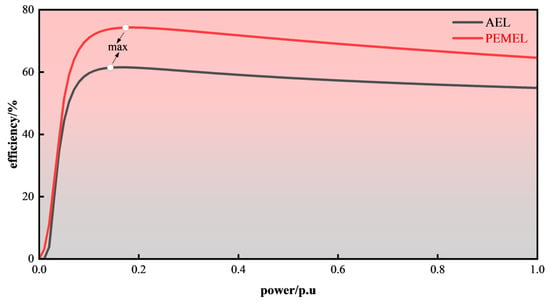
Figure 2.
Hydrogen production efficiency characteristics of two electrolytic cells.
3. Multi-Mode Electrolyzer Cluster Control Optimization
3.1. Electrolyzer Operating State Division Under Complex Operating Conditions
To ensure the safety and efficiency of the electrolysis-based hydrogen production system, this paper divides the operating power of electrolyzers into several operating intervals based on their operating characteristics (load range, startup time, and hydrogen production efficiency), as follows:
Rated Operation: The electrolyzer operates stably, safely, and efficiently at its rated power.
Overload Operation: Electrolyzers possess a certain overload capability, allowing them to withstand loads exceeding their rated power for short periods. AELs can typically operate under short-term overload conditions at 110–130% of their rated power, while PEMELs can endure even higher overload levels, usually ranging from 120% to 130% of their rated power. Utilizing this characteristic, the required electrolyzer capacity can be reduced. In this study, the overload power was defined as σ (1.26) times the rated power [].
Standby Operation: In this state, the system pauses hydrogen production but still consumes energy to maintain a specific temperature and pressure inside the electrolyzer (set at 2% of the rated power), allowing for rapid restart. The system can resume hydrogen production quickly when returning from standby [].
Fluctuating Operation: The regulation capability of electrolyzers refers to their ability to quickly adjust from high-temperature, high-power conditions to low-temperature, low-power conditions. Under high-temperature operating conditions, electrolyzers can achieve wide-range power adjustments within milliseconds. However, at low temperatures, their dynamic response significantly deteriorates, exhibiting noticeable hysteresis in the power regulation process, with transitions from low to high power typically requiring several minutes. Compared to AEL, PEMEL offers greater flexibility in power regulation. Due to its use of a solid electrolyte membrane, PEMEL can rapidly respond to changes in power input, adjust hydrogen production, and maintain high efficiency within a short time. In contrast, AEL has a slower response because of the lower conductivity of its electrolyte, making it less adaptable to load variations. As a result, PEMEL is significantly more advantageous in handling large power fluctuations in wind and solar power generation systems [].
Optimal Operation: Based on the analysis of the power-efficiency characteristics, the hydrogen production efficiency of the electrolyzer decreased as the power increased, with the peak occurring around 20% of the rated power. However, prolonged operation at low power may cause the hydrogen concentration in the oxygen to approach the lower explosive limit. Therefore, to ensure high electrolysis efficiency, reduce the probability of downtime, and improve the system’s adjustment sensitivity, it is recommended to set the optimal operating power at 50% of the rated power.
Shutdown: In this state, the electrolyzer is turned off and gradually cools, with no current flowing through the electrolyzer.
In summary, the operating scheduling process of the electrolyzer can be divided into three modes: standby, idle, and production. The fluctuating operation, rated operation, optimal operation, and overload operation are classified as production modes (NO), while the standby operation is classified as standby mode (STB) and the shutdown operation is considered idle mode (OFF). The relationships between variables and power are represented in Equations (6) and (7). The transition times between different modes are represented by binary variables, denoted as startup interval (Y) and shutdown interval (Z). Figure 3 illustrates the transition diagram between each operating mode.
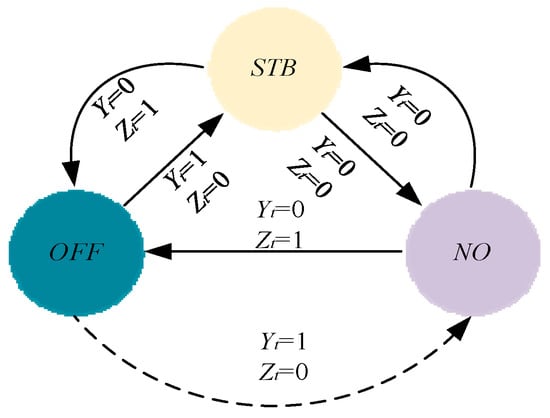
Figure 3.
Operating mode diagram.
At any given moment, only one of the three modes can be active, therefore:
Based on the electrolyzer power and hydrogen production relationship, the input–output correlation combined with binary variables for mode switching allows for calculating hydrogen output. The linearized hydrogen production rate function for the transition from standby to production mode is []:
where A1 and A2 are the electrolyzer power–hydrogen production rate characteristic parameters; A3 is the penalty coefficient for the hydrogen production transition from standby to production mode; is the electrolyzer power at time t; PS is the standby running power; and is the hydrogen production rate at time t.
3.2. Design of Power Matching Mechanism for Electrolyzer Cluster
For this paper, a comparative analysis of the startup time, response time, hydrogen production efficiency, hydrogen production rate, and safety and reliability of two types of electrolyzers was conducted, as shown in Figure 4. Compared to a single electrolyzer, the collaborative operation of PEMEL and AEL can better balance the advantages in terms of startup time, response speed, energy efficiency, and cost. Therefore, this work employed a hybrid approach of the two types of electrolyzers to coordinate hydrogen production and optimize the power control of the system. Based on the differences in the advantages and disadvantages of PEMEL and AEL, a matching mechanism between operating states and different electrolyzer types was planned.

Figure 4.
Comparison of characteristics of two types of electrolyzers.
In the wind–solar–hydrogen coupled system, the total power is divided into different levels based on output size, including overload conditions, optimal conditions, standby conditions, and low-power conditions, in order to maximize the absorption of wind and solar output power. To fully utilize the advantages of PEMEL in adapting to fluctuating power sources, the fluctuating state will only exist within the PEMEL cluster. Due to the longer response time of AEL, AEL will prioritize being in standby mode while PEMEL is in operation. Different operating conditions will be assigned to multi-state electrolyzers, with the allocation diagram shown in Figure 5. Under overload conditions, the total power of the electrolyzers will exceed their rated total and the electrolyzers will operate in overload, rated, and fluctuating states. Except for the PEMEL operating in fluctuating mode, the remaining electrolyzers will operate in rated mode. If the wind–solar power is still not fully absorbed, the electrolyzers will be sequentially upgraded to overload mode until the input power is fully absorbed. Similarly, under optimal, standby, and low-power conditions, electrolyzers will operate in optimal, standby, and shutdown states, with excess power being gradually increased to rated, optimal, and standby states, until the wind–solar power is fully absorbed.
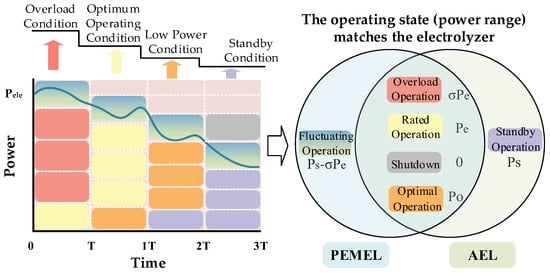
Figure 5.
Operating matching mechanism. A curve represents the power (Pele).
3.3. Optimization of Rotational Control Strategy for Composite Electrolyzer Cluster
Based on the theoretical research above, to better manage and optimize the electrolyzer system operation, this work implemented a modular control strategy for the electrolyzer system. The electrolyzer cluster was divided into n equal-sized AEL modules and N PEMEL modules, with each module named as AEL1 … AELn and PEMEL1 … PEMELN. One PEMEL was designated to operate in a fluctuating state, while the remaining electrolyzers were assigned to other operating states according to the wind and solar output power. Among them, AEL modules will prioritize a standby operation rather than shutdown, while PEMEL modules will prioritize operating in an overload state over AEL. To balance the operational load of each module, a time period T (where T is less than the hydrogen production safe power operating time) was set. After each period T, the operating states of both types of electrolyzers were changed sequentially, with the next electrolyzer inheriting the operating state of the previous one. The first electrolyzer would inherit the operating state of the last electrolyzer, while standby and fluctuating states would remain fixed within their respective electrolyzer cluster ranges. The rotational operation diagram is shown in Figure 6.
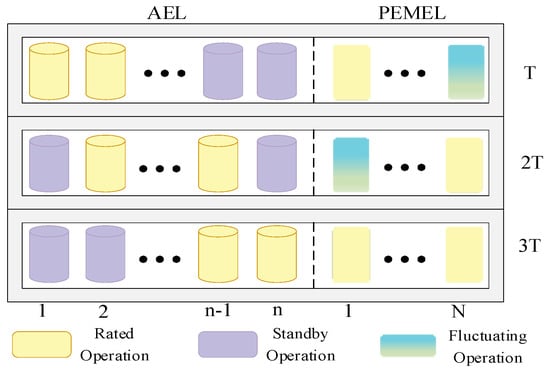
Figure 6.
Multi-state rotation operation diagram.
The multi-state hydrogen production process is shown in Figure 7. Ptotal represents the total renewable energy power that needs to be absorbed, Pe is the rated power of the electrolyzer, Pel is the total rated power of the electrolyzer cluster, Ps is the standby power of the electrolyzer, Po is the optimal power of the electrolyzer, Pb is the power during fluctuating operation, and σ is the overload factor. The specific operational conditions of the electrolyzer cluster under different working scenarios were as follows.

Figure 7.
Multi-state hydrogen production flowchart.
3.3.1. Overload Condition
When , all electrolyzers are operating at their rated power, but the wind and solar power output has not yet been fully absorbed. To reduce the configuration capacity of the electrolyzer system, short-term overload operation can be considered. Assuming the number of electrolyzers operating in the overload state is k4, then:
In this operating condition, only three states exist: overload, rated, and fluctuating. When the operating duration of the electrolyzers reaches the rotation period T, the electrolyzers switch their operating states according to the rotation strategy.
3.3.2. Optimum Operating Condition
When , the number of electrolyzers operating at rated power is less than the total number and the available power is insufficient to support all electrolyzers running at rated power. In this case, some electrolyzers will operate at the optimal power level. Assuming the number of electrolyzers operating at rated power is k3, then the number of electrolyzers operating at optimal power is:
In this operating condition, only three states exist: rated, optimal, and fluctuating. The rotation strategy follows the same principle.
3.3.3. Low-Power Condition
When , the fluctuating wind and solar input power is relatively low, and if the electrolyzers are mostly in the rated state, it will lead to widespread stagnation of the electrolyzers. Therefore, the electrolyzers should be maximized in the low-power, high-efficiency optimal power state while the remaining electrolyzers operate in standby and fluctuating states. Assuming that k2 electrolyzers are in the optimal state, then:
This operating condition involves only three states: standby, optimal, and fluctuating. The rotation method is the same.
3.3.4. Standby Condition
When , to ensure that the electrolyzers can quickly restart, AEL will prioritize operating in standby mode. Let the number of electrolyzers in standby mode be k1; then:
In this operating condition, there are only three states: shutdown, standby, and fluctuation. The rotation method is the same.
4. Simulation Verification
To validate the effectiveness of the proposed control method under fluctuating wind and solar power output, this work used wind and solar data from a region in Southwest China as a case study. The planned installed capacity consisted of a 200 kW wind turbine and a 300 kW photovoltaic power generation system. The annual wind and solar power output is shown in Figure 8.

Figure 8.
Wind–solar power curve.
4.1. Stability of Electrolyzer Cluster
To improve the overall hydrogen production efficiency of the electrolyzer cluster compared to traditional sequential startup and shutdown methods and single electrolyzer operation, this work effectively utilized the operational advantages of different electrolyzers to enhance the performance of the electrolyzer cluster. Based on the wind and solar power output and the characteristics of the electrolyzers, a cluster consisting of nine electrolyzers, each with a capacity of 20 kW, was considered. After the comprehensive consideration of multiple performance indicators, a capacity ratio of 2:1 for AEL to PEMEL was selected as the system configuration scheme []. To better analyze the control strategy proposed for this paper, a 120 min period with no power curtailment from Figure 8 was selected, with the power range from 0 to 226.8 kW. The switching time was set to 12 min, and the electrolyzer operating states were rotated every 12 min in a cyclic manner. To highlight the advantages of the proposed strategy, a comparison of the single electrolyzer power fluctuations under both methods is shown in Figure 9.
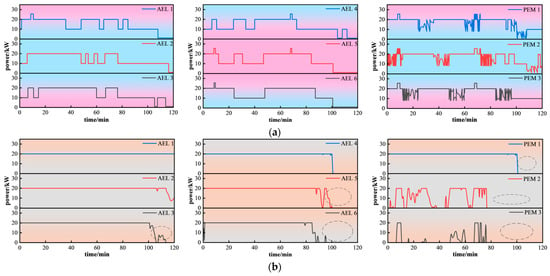
Figure 9.
Comparison of single power fluctuation of the two electrolytic cells: (a) power fluctuation curves of each electrolyzer under the composite rotation strategy; (b) power fluctuation curves of each electrolyzer under the traditional start–stop strategy.
According to the comparative analysis in Figure 9, under the traditional sequential start–stop strategy, when the wind and solar input power exceeded the rated capacity of the electrolyzers, the system typically required additional electrolyzer capacity or faced the curtailment of wind and solar energy, as the overload characteristics of the electrolyzers were not considered. When the input power was relatively low, the front-end electrolyzers operated for extended periods, while most of the rear-end electrolyzers remained idle. Additionally, the traditional start–stop strategy did not account for the efficiency characteristics of electrolyzers, and it failed to mitigate shutdown occurrences through low-power, high-efficiency operation modes. Furthermore, when wind and solar input power fluctuates within a small range for an extended time, a specific electrolyzer may remain in a fluctuating state, accelerating its wear and aging and reducing its operational efficiency. In contrast, the proposed composite rotation strategy effectively avoided the above issues by fully considering the operational characteristics of both types of electrolyzers, achieving a more reasonable power distribution across the electrolyzer cluster and improving the overall hydrogen production efficiency. It also enhanced the balance of the electrolyzer operation.
By analyzing the output power of each individual electrolyzer, the proportion of time each electrolyzer operated in different states during the system operation cycle is shown more intuitively in Table 1. The simulation results indicated the following:

Table 1.
Proportion of operating time for each state of the electrolyzer cell.
- (1)
- The control strategy proposed for this paper prevented the AEL from entering fluctuating and downtime states, with the PEM electrolyzer handling the majority of the fluctuating power, accounting for over 33%. This ensured that the system not only reduced frequent start–stop situations but also fully utilized the strong capability of PEMEL to adapt to fluctuating power sources.
- (2)
- The rated operating time of AELs ranges from 42.76% to 51.71%, while that of PEMELs is mostly between 46.85% and 51.43%. This indicates that the system operated at rated power for the majority of the time, ensuring safe and efficient hydrogen production.
- (3)
- Compared to PEMELs, AELs exhibit relatively longer optimal operating durations, accounting for 33.15% to 49.25% of the total time. This suggests that AELs operate in their optimal state more frequently, effectively enhancing hydrogen production efficiency.
- (4)
- The introduction of a standby state reduces the probability of electrolyzer shutdowns and ensures the continuity of system operation.
The comprehensive indicators of the electrolyzer cluster can effectively reflect its service life and safety. To more intuitively demonstrate the balance of operating time, this work used standard deviation and coefficient of variation to measure the operating states of the electrolyzers. Specifically, the larger the standard deviation and coefficient of variation were, the more inconsistent the operating states of the electrolyzer cluster were; conversely, the smaller the standard deviation and coefficient of variation were, the more consistent the operating states of the electrolyzers were. This method enables a more effective evaluation of the balance and consistency of the electrolyzer cluster under different operating conditions, thus helping to better understand the performance characteristics of the electrolyzers and the factors that may affect their service life and safety. This method provides an important reference for optimizing the operational stability of the electrolyzer cluster and extending the system’s lifespan.
Standard deviation (SD):
Coefficient of variation (CV):
Given that rated operation is the most common and ideal state for electrolyzers, this work specifically focused on the degree of dispersion in the operating time distribution under this state. As shown in Figure 10, a comparative analysis was conducted between the traditional sequential startup and shutdown method and the composite rotation method concerning the dispersion of rated operating time. The standard deviation and coefficient of variation for the composite rotation method were 2.82 min and 0.06, respectively, while for the traditional sequential startup and shutdown method, the standard deviation and coefficient of variation were 30.53 min and 47.10. Compared to the traditional sequential startup and shutdown method, the composite rotation method reduced the standard deviation and coefficient of variation by 27.71 min and 47.04, respectively.
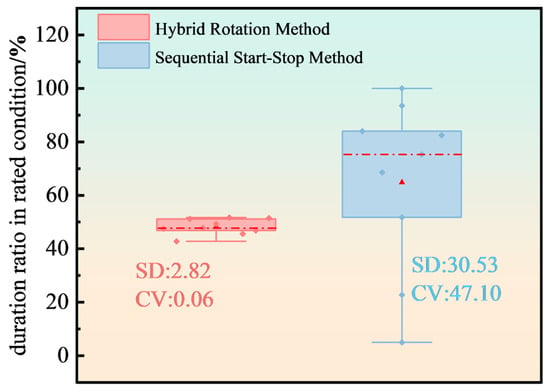
Figure 10.
Discreteness of rated operating duration for two methods.
4.2. Dynamic Real-Time Response Performance Analysis of Electrolyzers
To validate the effectiveness of the proposed control strategy in adjusting the response during actual operation, this work focused on the dynamic response performance of electrolyzers in different states. Taking PEMEL as an example, a comparative analysis was conducted between the proposed strategy and the traditional sequential control method. Figure 11a shows the dynamic response curves of power and the hydrogen production rate when the electrolyzer switched between different states under the composite rotation method. From the figure, it can be seen that the response times for the electrolyzer switching from standby to rated operation were 1.5 s and 1.7 s, respectively. Additionally, considering the delay time caused by the inertia of the pipeline and gas–liquid separation, the total power adjustment response time and total hydrogen production delay time when the electrolyzer switched from standby to rated state were 3.2 s and 3.68 s, respectively.
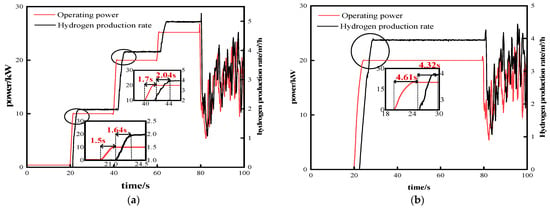
Figure 11.
The response performance of different electrolytic cell operations: (a) hybrid rotation method; (b) sequential start–stop method.
In contrast, the traditional sequential startup and shutdown method does not fully take into account the overload characteristics of the electrolyzer. The electrolyzer typically operates at rated power or fluctuates between states, with power adjustment response times and hydrogen production delay times of 4.61 s and 4.32 s, respectively, as shown in Figure 11b. Therefore, compared to the traditional sequential startup and shutdown method, the proposed control strategy reduced the power adjustment response time and hydrogen production delay time to rated power by 1.41 s and 0.64 s, respectively. The results indicate that, under the composite rotation control method, the electrolyzer’s response speed can effectively follow state switching.
4.3. Effectiveness of Optimized Control Strategies for Electrolyzer Clusters
Figure 12 shows the hydrogen production efficiency variations in each electrolyzer under the two control methods. It can be seen from the figure that, under the proposed method, the electrolyzer efficiency of PEMEL was significantly higher than that of the traditional method and the shutdown probability was lower. In cases of significant fluctuations in wind and solar power, the traditional method causes the later electrolyzers to frequently shut down, resulting in lower hydrogen production efficiency. In contrast, the hybrid rotation method effectively mitigated these fluctuations during significant jumps in wind and solar input power. The proposed control method not only significantly reduced the shutdown probability of electrolyzers but also effectively enhanced the overall hydrogen production efficiency of the system.
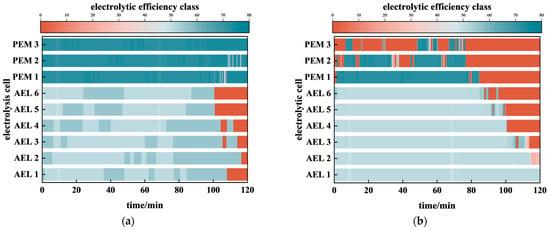
Figure 12.
The electrolysis efficiency of each electrolyzer under the two methods is shown in the following diagram: (a) hybrid rotation method; (b) sequential start–stop method.
As shown in Figure 13, under the condition of 120 min input fluctuating wind–solar power, the two types of electrolyzers exhibited significant uniformity in hydrogen production after power optimization. The hydrogen output of the AEL ranged between 3.95 Nm3 and 4.25 Nm3, while the PEMEL maintained a stable hydrogen output of approximately 6.52 Nm3. However, under low wind and solar power input, the conventional sequential startup method caused the front-end electrolyzers to remain in operation for extended periods, while a large portion of the back-end electrolyzers ceased operation, resulting in significant discrepancies in hydrogen production. The hydrogen production of AEL ranged from 4.04 Nm3 to 5.77 Nm3, whereas PEMEL varied between 0.84 Nm3 and 5.17 Nm3.
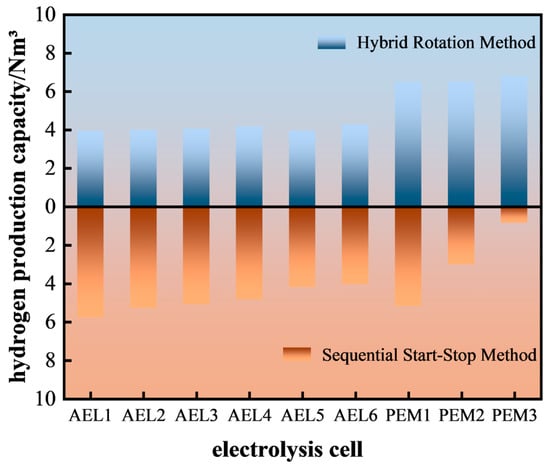
Figure 13.
Comparison of hydrogen content in each cell of the two methods.
Overall, the hydrogen production consistency of individual electrolyzers under the proposed strategy was significantly higher than that of the conventional startup method, and the average hydrogen production also exceeded that of the conventional approach. In the simulated scenario, the total hydrogen production of the conventional method was 38.22 Nm3, whereas the optimized power allocation strategy increased the total hydrogen production to 42.32 Nm3, representing an overall improvement of 10.73%. By adopting the proposed power optimization strategy, the operational characteristics of both types of electrolyzers were fully considered, ensuring rational power distribution among electrolyzers and maximizing efficiency. Additionally, the operational balance of the electrolyzers was improved, verifying the effectiveness of the proposed strategy.
5. Conclusions
This paper addresses the demands for efficiency, economy, and reliability in renewable energy-based electrolysis hydrogen production systems. By thoroughly analyzing the operational response characteristics and working constraints of two types of electrolyzers, the paper aims to enhance the overall hydrogen production and electrolyzer cluster stability under the same input power. A refined planning approach for the electrolyzer cluster’s operational states is proposed, and a renewable energy electrolysis hydrogen production system model that accounts for the impact of fluctuating power is established. A multi-mode hybrid electrolyzer rotation control strategy, considering the optimization needs of electrolysis hydrogen production, is introduced. Theoretical analysis and simulation results show that:
- (1)
- Under the same wind and solar power output conditions, the differentiated utilization of the operational response characteristics of AEL and PEMEL helps improve the operational efficiency and stability of the electrolysis hydrogen production system. Compared with the traditional sequential start–stop method, the proposed strategy increases the overall hydrogen production by 10.73%, and the hydrogen production from both electrolyzer types shows significant uniformity.
- (2)
- Compared with the traditional sequential start–stop method, the proposed strategy reduces the standard deviation and coefficient of variation in the system’s rated operation duration by 27.71 min and 47.04, respectively. This balances the operational duration of individual electrolyzers in the rated state, indirectly extending the working life of the electrolyzer cluster.
Author Contributions
Methodology, Q.T.; project administration, K.L.; resources, W.H. and K.L.; writing—original draft preparation, Q.T. and L.X.; writing—review and editing, Q.T., M.C. and L.Z.; supervision, W.H. and K.L. All authors have read and agreed to the published version of the manuscript.
Funding
The central government guides local funds for science and technology development, grant number 2023ZYDF043.
Data Availability Statement
The original contributions presented in the study are included in the article, further inquiries can be directed to the corresponding author.
Conflicts of Interest
The authors declare no conflicts of interest.
Appendix A

Table A1.
Fixed model parameters.
Table A1.
Fixed model parameters.
| Parameter | Value | Parameter | Value |
|---|---|---|---|
| Isc | 2.69 A | Uoc | 7.2 V |
| Um | 6.0 V | Im | 2.5 A |
| β | 0° | ρ | 1.29 kg/m3 |
| T | 298 K | nω | 100 r/min |
| 1 | R | 8.3144 J·mol−1K−1 | |
| αan | 0.8 | F | 96,485 C·mol−1 |
| αcat | 0.25 | A | 160 cm2 |
| io,cat | 1 × 10−1 A/cm2 | λ | 21 |
| io,an | 1 × 10−7 A/cm2 | δmem | 0.0254 cm |
| ρeff | 18.1 × 10−6 Ωcm | δel | 0.008 cm |
| ε | 0.3 | r1 | 8.232 × 10−5 Ωcm2 |
| ξ | 4 | r2 | −4.51 × 10−7 Ωcm2 |
| 59.7 K | z | 2 | |
| 106.7 K | εH2O | 809.1 K |
References
- Moghaddam, A.L.; Hejazi, S.; Fattahi, M.; Kibria, M.G.; Thomson, M.J.; AlEisa, R.; Khan, M.A. Methane Pyrolysis for Hydrogen Production: Navigating the Path to a Net Zero Future. Energy Environ. Sci. 2025, 18, 2747–2790. [Google Scholar] [CrossRef]
- Guo, Y.; Li, G.; Zhou, J.; Liu, Y. Comparison Between Hydrogen Production by Alkaline Water Electrolysis and Hydrogen Production by PEM Electrolysis. IOP Conf. Ser. Earth Environ. Sci. 2019, 371, 042022. [Google Scholar] [CrossRef]
- Huang, Q.F.; Chen, J.; Cao, X.M.; Liu, J.; Zhang, Y.; Bao, Y. Optimization of wind-photovoltaic complementation hydrogen production system based on synergistic hydrogen production by alkaline electrolyzer and proton exchange membrane electrolyzer. Electr. Power Autom. Equip. 2023, 43, 168–174. [Google Scholar]
- Zheng, B.; Bai, Z.; Yuan, Y.; Hu, X. Hydrogen production system and capacity optimization based on synergistic operation with multi-type electrolyzers under wind-solar power. Proc. CSEE 2022, 42, 8486–8496. [Google Scholar]
- Jiang, Y.W.; Yang, G.M.; Chen, Y.X.; Huang, W. Optimal operation for the hydrogen network under consideration of the dynamic hydrogen production efficiency of electrolyzers. Proc. CSEE 2023, 43, 3014–3027. [Google Scholar]
- Yuan, T.J.; Wan, Z.; Wang, J.J.; Zhang, D.; Jiang, D. The day-ahead output plan of hydrogen production system considering the startstop characteristics of electrolytic cell. Electr. Power 2022, 55, 101–109. [Google Scholar]
- Shen, X.J.; Nie, C.Y.; Lv, H. Coordination control strategy of wind power-hydrogen alkaline electrolyzerbank considering electrothermal characteristics. Trans. China Electrotech. Soc. 2021, 36, 463–472. [Google Scholar]
- Niu, M.; Hong, Z.P.; Li, B.; Li, X. Optimal control strategy of wind power to hydrogen system considering electrolyzer efficiency improvement. Acta Energiae Solaris Sin. 2023, 44, 366–376. [Google Scholar]
- Chen, M.P.; Ren, J.X.; Li, F.Q. Coordinated and stable operation of wind solar complementarity and load of electrolytic water hydrogen production system. Acta Energiae Solaris Sin. 2023, 44, 344–350. [Google Scholar]
- Cao, X.; Wang, J.; Zhao, P.; Xia, H.; Li, Y.; Sun, L.; He, W. Hydrogen production system using alkaline water electrolysis adapting to fast fluctuating photovoltaic power. Energies 2023, 16, 3308. [Google Scholar] [CrossRef]
- Abdin, Z.; Webb, C.J.; Gray, E.M.A. Modelling and simulation of a proton exchange membrane (PEM) electrolyser cell. Int. J. Hydrogen Energy 2015, 40, 13243–13257. [Google Scholar] [CrossRef]
- Abdin, Z.; Webb, C.J.; Gray, E.M.A. Modelling and simulation of an alkaline electrolyser cell. Energy 2017, 138, 316–331. [Google Scholar] [CrossRef]
- Yang, J.; Zhang, J.; Liu, M.; Sun, J.; Shangguan, Z. Dynamic simulation and performance analysis of alkaline water electrolyzers for renewable energy-powered hydrogen production. Energies 2024, 17, 4915. [Google Scholar] [CrossRef]
- Wei, F.R.; Sui, Q.; Lin, X.N.; Li, Z.; Chen, L.; Zhao, B.; Xu, C.; Adio, O.S. Scheduling optimization strategy of coal-air hydrogen energy network considering efficiency characteristics of hydrogen production equipment. Proc. CSEE 2018, 38, 1428–1439. [Google Scholar]
- Fang, R.; Liang, Y. Control strategy of electrolyzer in a wind-hydrogen system considering the constraints of switching times. Int. J. Hydrogen Energy 2019, 44, 25104–25111. [Google Scholar] [CrossRef]
- Shen, X.; Zhang, X.; Li, G.; Lie, T.T.; Hong, L. Experimental study on the external electrical thermal and dynamic power characteristics of alkaline water electrolyzer. Int. J. Energy Res. 2018, 42, 3244–3257. [Google Scholar] [CrossRef]
- Varela, C.; Mostafa, M.; Zondervan, E. Modeling alkaline water electrolysis for power-to-x applications: A scheduling approach. Int. J. Hydrogen Energy 2021, 46, 9303–9313. [Google Scholar] [CrossRef]
- Matute, G.; Yusta, J.M.; Correas, L.C. Techno-economic modelling of water electrolysers in the range of several MW to provide grid services while generating hydrogen for different applications: A case study in Spain applied to mobility with FCEVS. Int. J. Hydrogen Energy 2019, 44, 17431–17442. [Google Scholar] [CrossRef]
- Chen, Z.X.; Zhang, Y.C.; Zhu, S.; Xie, S. Optimal scheduling electricity-hydrogen-heat integrated energy system considering combined operation of multi-electrolyzers under multiple conditions. Power Syst. Technol. 2025, 49, 542–551. [Google Scholar]
- Li, J.L.; Liang, Z.H.; Zhao, W.D.; Li, G.; Li, M. Selection and evaluation method of hydrogen production system in hybrid electrolytic cell. High Volt. Eng. 2024, 50, 2653–2662. [Google Scholar]
Disclaimer/Publisher’s Note: The statements, opinions and data contained in all publications are solely those of the individual author(s) and contributor(s) and not of MDPI and/or the editor(s). MDPI and/or the editor(s) disclaim responsibility for any injury to people or property resulting from any ideas, methods, instructions or products referred to in the content. |
© 2025 by the authors. Licensee MDPI, Basel, Switzerland. This article is an open access article distributed under the terms and conditions of the Creative Commons Attribution (CC BY) license (https://creativecommons.org/licenses/by/4.0/).